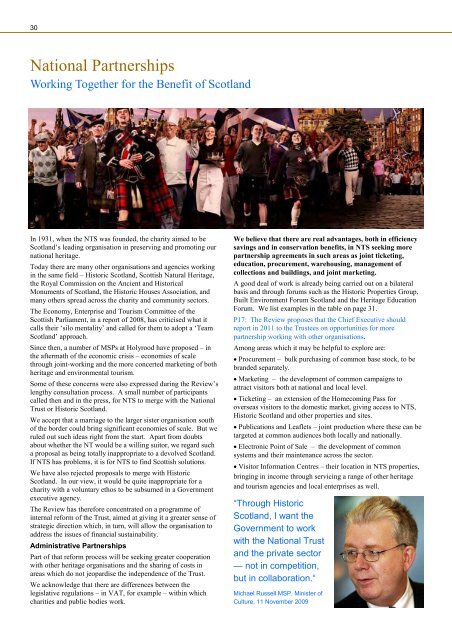NTS Report 4 Aug 2010 - National Trust for Scotland
NTS Report 4 Aug 2010 - National Trust for Scotland
NTS Report 4 Aug 2010 - National Trust for Scotland
Create successful ePaper yourself
Turn your PDF publications into a flip-book with our unique Google optimized e-Paper software.
30<br />
<strong>National</strong> Partnerships<br />
Working Together <strong>for</strong> the Benefit of <strong>Scotland</strong><br />
In 1931, when the <strong>NTS</strong> was founded, the charity aimed to be<br />
<strong>Scotland</strong>’s leading organisation in preserving and promoting our<br />
national heritage.<br />
Today there are many other organisations and agencies working<br />
in the same field – Historic <strong>Scotland</strong>, Scottish Natural Heritage,<br />
the Royal Commission on the Ancient and Historical<br />
Monuments of <strong>Scotland</strong>, the Historic Houses Association, and<br />
many others spread across the charity and community sectors.<br />
The Economy, Enterprise and Tourism Committee of the<br />
Scottish Parliament, in a report of 2008, has criticised what it<br />
calls their ‘silo mentality’ and called <strong>for</strong> them to adopt a ‘Team<br />
<strong>Scotland</strong>’ approach.<br />
Since then, a number of MSPs at Holyrood have proposed – in<br />
the aftermath of the economic crisis – economies of scale<br />
through joint-working and the more concerted marketing of both<br />
heritage and environmental tourism.<br />
Some of these concerns were also expressed during the Review’s<br />
lengthy consultation process. A small number of participants<br />
called then and in the press, <strong>for</strong> <strong>NTS</strong> to merge with the <strong>National</strong><br />
<strong>Trust</strong> or Historic <strong>Scotland</strong>.<br />
We accept that a marriage to the larger sister organisation south<br />
of the border could bring significant economies of scale. But we<br />
ruled out such ideas right from the start. Apart from doubts<br />
about whether the NT would be a willing suitor, we regard such<br />
a proposal as being totally inappropriate to a devolved <strong>Scotland</strong>.<br />
If <strong>NTS</strong> has problems, it is <strong>for</strong> <strong>NTS</strong> to find Scottish solutions.<br />
We have also rejected proposals to merge with Historic<br />
<strong>Scotland</strong>. In our view, it would be quite inappropriate <strong>for</strong> a<br />
charity with a voluntary ethos to be subsumed in a Government<br />
executive agency.<br />
The Review has there<strong>for</strong>e concentrated on a programme of<br />
internal re<strong>for</strong>m of the <strong>Trust</strong>, aimed at giving it a greater sense of<br />
strategic direction which, in turn, will allow the organisation to<br />
address the issues of financial sustainability.<br />
Administrative Partnerships<br />
Part of that re<strong>for</strong>m process will be seeking greater cooperation<br />
with other heritage organisations and the sharing of costs in<br />
areas which do not jeopardise the independence of the <strong>Trust</strong>.<br />
We acknowledge that there are differences between the<br />
legislative regulations – in VAT, <strong>for</strong> example – within which<br />
charities and public bodies work.<br />
We believe that there are real advantages, both in efficiency<br />
savings and in conservation benefits, in <strong>NTS</strong> seeking more<br />
partnership agreements in such areas as joint ticketing,<br />
education, procurement, warehousing, management of<br />
collections and buildings, and joint marketing.<br />
A good deal of work is already being carried out on a bilateral<br />
basis and through <strong>for</strong>ums such as the Historic Properties Group,<br />
Built Environment Forum <strong>Scotland</strong> and the Heritage Education<br />
Forum. We list examples in the table on page 31.<br />
P17: The Review proposes that the Chief Executive should<br />
report in 2011 to the <strong>Trust</strong>ees on opportunities <strong>for</strong> more<br />
partnership working with other organisations.<br />
Among areas which it may be helpful to explore are:<br />
• Procurement – bulk purchasing of common base stock, to be<br />
branded separately.<br />
• Marketing – the development of common campaigns to<br />
attract visitors both at national and local level.<br />
• Ticketing – an extension of the Homecoming Pass <strong>for</strong><br />
overseas visitors to the domestic market, giving access to <strong>NTS</strong>,<br />
Historic <strong>Scotland</strong> and other properties and sites.<br />
• Publications and Leaflets – joint production where these can be<br />
targeted at common audiences both locally and nationally.<br />
• Electronic Point of Sale – the development of common<br />
systems and their maintenance across the sector.<br />
• Visitor In<strong>for</strong>mation Centres – their location in <strong>NTS</strong> properties,<br />
bringing in income through servicing a range of other heritage<br />
and tourism agencies and local enterprises as well.<br />
“Through Historic<br />
<strong>Scotland</strong>, I want the<br />
Government to work<br />
with the <strong>National</strong> <strong>Trust</strong><br />
and the private sector<br />
— not in competition,<br />
but in collaboration.“<br />
Michael Russell MSP, Minister of<br />
Culture, 11 November 2009













![Elgin Cathedral Wedding Brochure [pdf, 544kb] - Historic Scotland](https://img.yumpu.com/22301571/1/190x151/elgin-cathedral-wedding-brochure-pdf-544kb-historic-scotland.jpg?quality=85)



